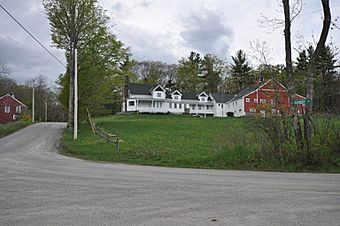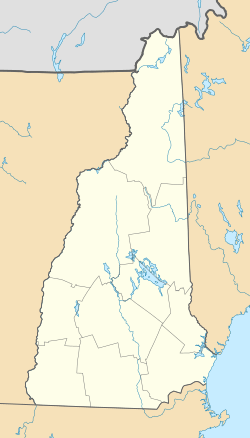Smith–Mason Farm facts for kids
The Smith–Mason Farm is a special old farm in Harrisville, New Hampshire. It's located where Meadow Road and Old Roxbury Road meet. This farm started way back in the late 1700s! Over the years, it has been used in different ways: first as a working farm, then as a summer home, and now as a regular family house. It shows how places in Harrisville have changed over time. Because it's so important, the farm was added to the National Register of Historic Places in 1988.
Quick facts for kids |
|
|
Smith–Mason Farm
|
|
 |
|
| Location | NW of Meadow and Old Roxbury Rds. intersection, Harrisville, New Hampshire |
|---|---|
| Area | 4.6 acres (1.9 ha) |
| Built | 1791 |
| MPS | Harrisville MRA |
| NRHP reference No. | 86003255 |
| Added to NRHP | January 14, 1988 |
Contents
What Does the Smith–Mason Farm Look Like?
The Smith–Mason Farm is in a quiet, countryside area in western Harrisville. It's just a bit northwest of where Meadow and Old Roxbury roads cross. The farm buildings are spread out and have many parts.
The Main House and Its Connections
The main house is a one-and-a-half-story building. It's built in a style called Greek Revival, which was popular a long time ago. This house is connected to a shed and a barn. This kind of setup, where the house, shed, and barn are all linked together, is a traditional style for farms in New England. It's called a connected farm.
Other Buildings on the Property
There's also another barn that stands across Old Roxbury Road from the main house. Plus, a smaller cottage is located close to the main group of buildings.
A Farm's Journey Through Time
The Smith–Mason Farm is a great example of how places in rural Harrisville have changed over the years. It shows different chapters of history.
How the Farm Began
The farm started as a working farm in 1791. A person named Abner Smith was the first owner. People believe that one part of the house today might have been Abner Smith's original home.
From Farm to Summer Getaway
In 1904, the farm changed. A woman named Sara Coe from New York City bought it. She turned it into a summer home, a place where she could relax during the warmer months. Sara added porches and special windows called roof dormers to the house. She even gave the property a new name: "Brookside."
Back to a Full-Time Home
Later in the 20th century, the property changed again. It went back to being a place where people lived all year round. This shows how the farm has adapted and been used in different ways throughout its long history.



